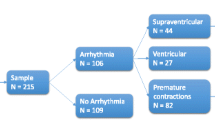Abstract
Objective: Incidence, types, and factors associated with new onset tachyarrhythmias (TA) in surgical intensive care patients.¶Design: Pairwise-matched case-controlled study. Setting: Surgical intensive care unit (ICU) with nine intensive care beds. Patients: During a 1-year period, all TA patients (n = 89) were included in the study. Control patients (n = 82) without TA were matched according to age, sex, and surgical region. Methods: TA workup included: 12-lead ECG, arterial blood gas, serum electrolyte (K+, Mg2+), and serum CK/CKMB isoenzyme analysis. Pre-existing cardiovascular and pulmonary disease, cardiovascular risk factors, preoperative regular medication, and admission SAPS were recorded in all patients. A multiple organ dysfunction syndrome (MODS) score, the presence or absence of SIRS or sepsis, and hemodynamics (MAP and CVP) before onset of TA were evaluated in TA patients, while in control patients highest MODSscore, the presence or absence of SIRS or sepsis, mean hemodynamic and laboratory values calculated from highest and lowest readings during ICU stay were used for statistical comparison. Logistic regression analysis was performed to identify variables multivariately associated with TA. Results: Eighty-nine (14.8 %) of 596 patients developed TA. Atrial fibrillation was most frequent (60.7 %). Presence of SIRS or sepsis (adj. OR = 36.45; 95 % CI: 11.5–115.5), high admission SAPS (adj. OR = 1.25/point; 95 % CI: 1.08–1.44), high CVP (adj. OR = 1.27/mmHg; 95 % CI: 1.09–1.48), and low arterial oxygen tension (adj. OR = 0.97/mmHg); 95 % CI: 0.95–0.99) were found to be significant predictors for development of TA. Conclusions: In surgical patients hypoxia, high cardiac filling pressures, a greater degree of physiologic derangement at admission, and the presence of SIRS and sepsis are independent risk factors for the development of TA.
Similar content being viewed by others
Author information
Authors and Affiliations
Additional information
Received: 23 September 1999/Final revision received: 25 January 2000/Accepted: 25 April 2000
Rights and permissions
About this article
Cite this article
Knotzer, H., Mayr, A., Ulmer, H. et al. Tachyarrhythmias in a surgical intensive care unit: a case-controlled epidemiologic study. Intensive Care Med 26, 908–914 (2000). https://doi.org/10.1007/s001340051280
Issue Date:
DOI: https://doi.org/10.1007/s001340051280




